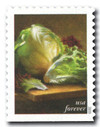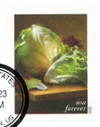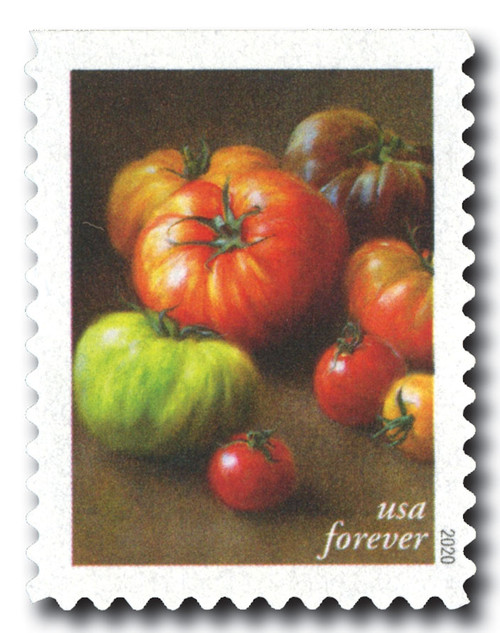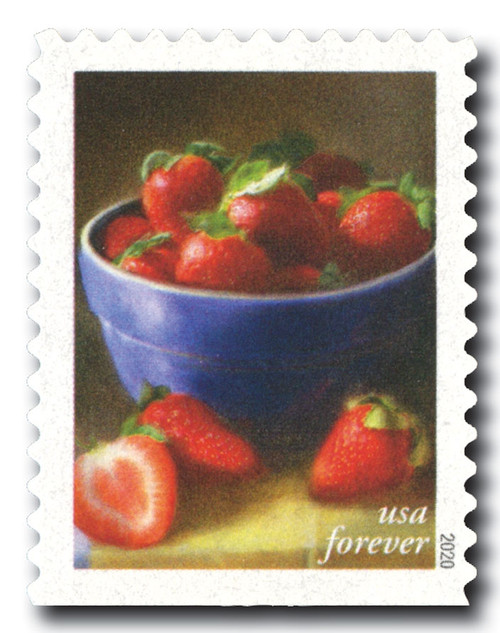
# 5490 - 2020 First-Class Forever Stamps - Fruits and Vegetables: Lettuces
US #5490
2020 Lettuce – Fruits and Vegetables
- Celebrates the tradition of using fruits and vegetables as subjects for still lifes
Stamp Category: Definitive
Set: Fruits and Vegetables
Value: 55¢ First Class Mail Rate (Forever)
First Day of Issue: July 17, 2020
First Day City: Charleston, West Virginia
Quantity Issued: 200,000,000
Printed by: Banknote Corporation of America
Printing Method: Offset
Format: Double-sided booklets of 20
Tagging: Phosphor tagged paper, block
Why the stamps were issued: To show off the simple beauty of fruits and vegetables.
About the stamp designs: Pictures existing artwork of several types of lettuce by Robert Papp.
First Day City: According to the USPS, Charleston, West Virginia, was chosen for the First Day of Issue postmark because of the city’s famous Capitol Market, a year-round farmers’ market and nonprofit organization. There was no First Day of Issue Ceremony due to the Covid-19 pandemic.
About the Fruits and Vegetables set: Includes 10 different stamps designs all picturing a different fruit or vegetable still life by Robert Papp.
History the stamp represents: When planning your very first garden, one of the easiest vegetables to start with is lettuce. With its many varieties and fairly short growing time, you will never get bored of leafy greens.
Lettuce will happily grow in a garden patch or outdoor container. Whichever you choose, start by sprinkling the lettuce seeds on the soil and barely covering them with dirt. While they are sprouting, it is important to keep the soil moist, but not too wet (easy to do if you use a spray bottle). You can start your seeds indoors in late winter or sow them directly into your garden or outdoor container once the danger of frost has passed. Lettuce likes cooler temperatures, so it is best to grow and harvest in spring and fall rather than summer.
When your lettuce seedlings have reached an inch tall, be sure to thin out smaller seedlings (cut them off at the ground or gently pull them up) until there are six or eight inches between plants. As lettuce grows into its adult form, be sure to keep the soil moist. You can harvest most baby lettuces when they reach three or four inches tall, or you can wait until plants reach full size.
The best way to get the most out of your lettuce harvest (except in the case of varieties like iceberg) is to remove outer leaves first. Since lettuce grows from the center, harvesting the oldest leaves will give you an almost continuous supply of delicious greens to enjoy.
US #5490
2020 Lettuce – Fruits and Vegetables
- Celebrates the tradition of using fruits and vegetables as subjects for still lifes
Stamp Category: Definitive
Set: Fruits and Vegetables
Value: 55¢ First Class Mail Rate (Forever)
First Day of Issue: July 17, 2020
First Day City: Charleston, West Virginia
Quantity Issued: 200,000,000
Printed by: Banknote Corporation of America
Printing Method: Offset
Format: Double-sided booklets of 20
Tagging: Phosphor tagged paper, block
Why the stamps were issued: To show off the simple beauty of fruits and vegetables.
About the stamp designs: Pictures existing artwork of several types of lettuce by Robert Papp.
First Day City: According to the USPS, Charleston, West Virginia, was chosen for the First Day of Issue postmark because of the city’s famous Capitol Market, a year-round farmers’ market and nonprofit organization. There was no First Day of Issue Ceremony due to the Covid-19 pandemic.
About the Fruits and Vegetables set: Includes 10 different stamps designs all picturing a different fruit or vegetable still life by Robert Papp.
History the stamp represents: When planning your very first garden, one of the easiest vegetables to start with is lettuce. With its many varieties and fairly short growing time, you will never get bored of leafy greens.
Lettuce will happily grow in a garden patch or outdoor container. Whichever you choose, start by sprinkling the lettuce seeds on the soil and barely covering them with dirt. While they are sprouting, it is important to keep the soil moist, but not too wet (easy to do if you use a spray bottle). You can start your seeds indoors in late winter or sow them directly into your garden or outdoor container once the danger of frost has passed. Lettuce likes cooler temperatures, so it is best to grow and harvest in spring and fall rather than summer.
When your lettuce seedlings have reached an inch tall, be sure to thin out smaller seedlings (cut them off at the ground or gently pull them up) until there are six or eight inches between plants. As lettuce grows into its adult form, be sure to keep the soil moist. You can harvest most baby lettuces when they reach three or four inches tall, or you can wait until plants reach full size.
The best way to get the most out of your lettuce harvest (except in the case of varieties like iceberg) is to remove outer leaves first. Since lettuce grows from the center, harvesting the oldest leaves will give you an almost continuous supply of delicious greens to enjoy.














